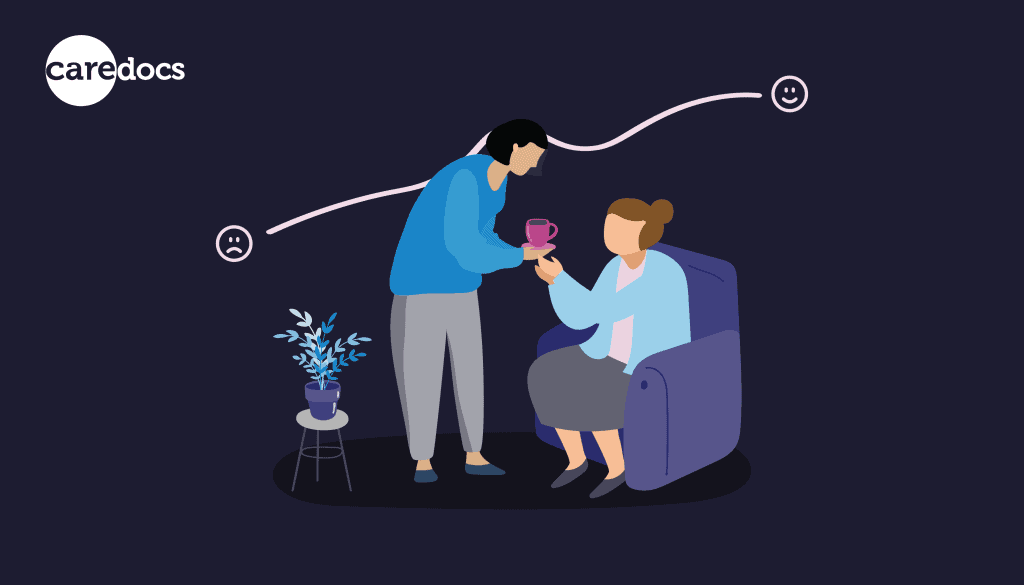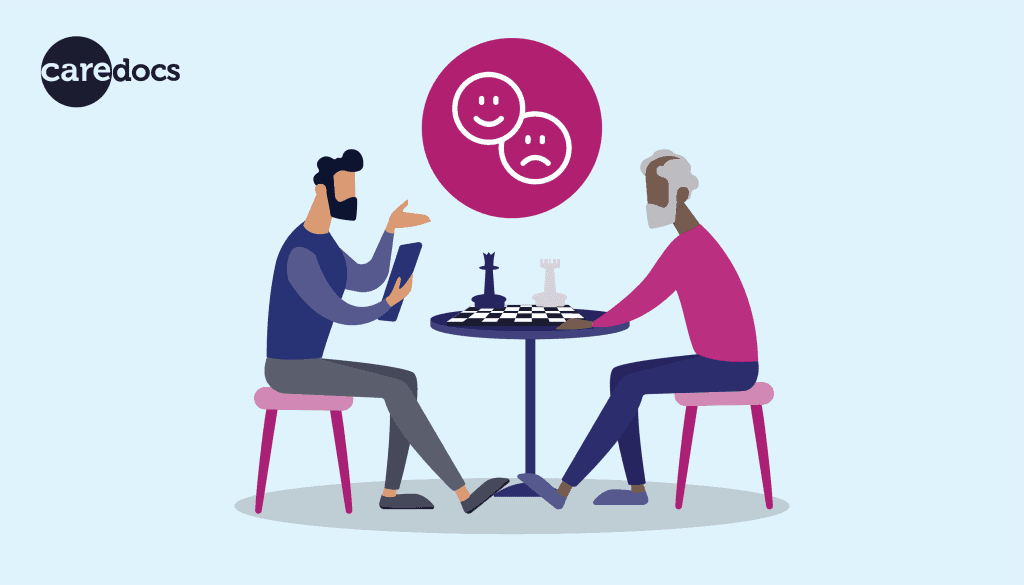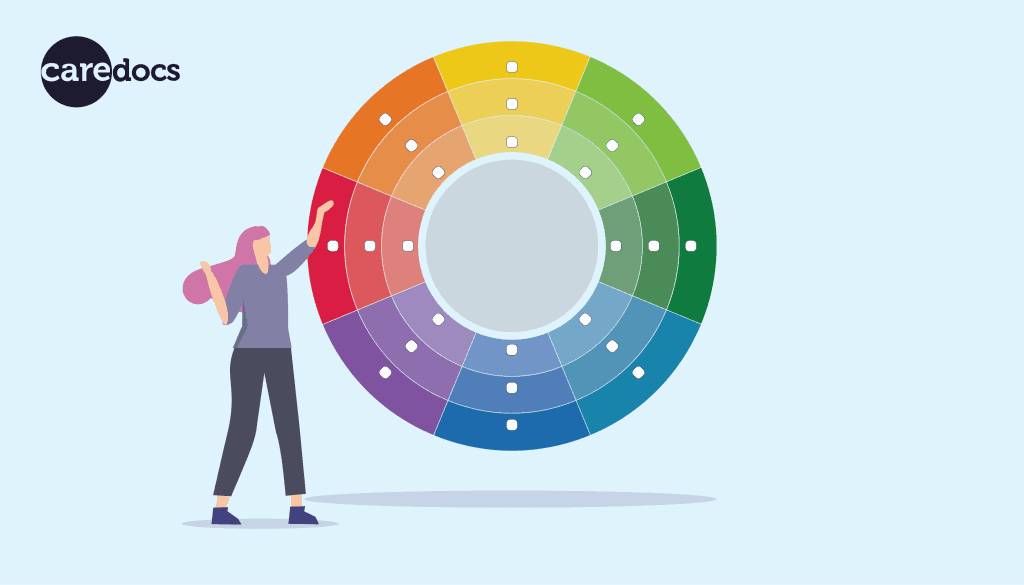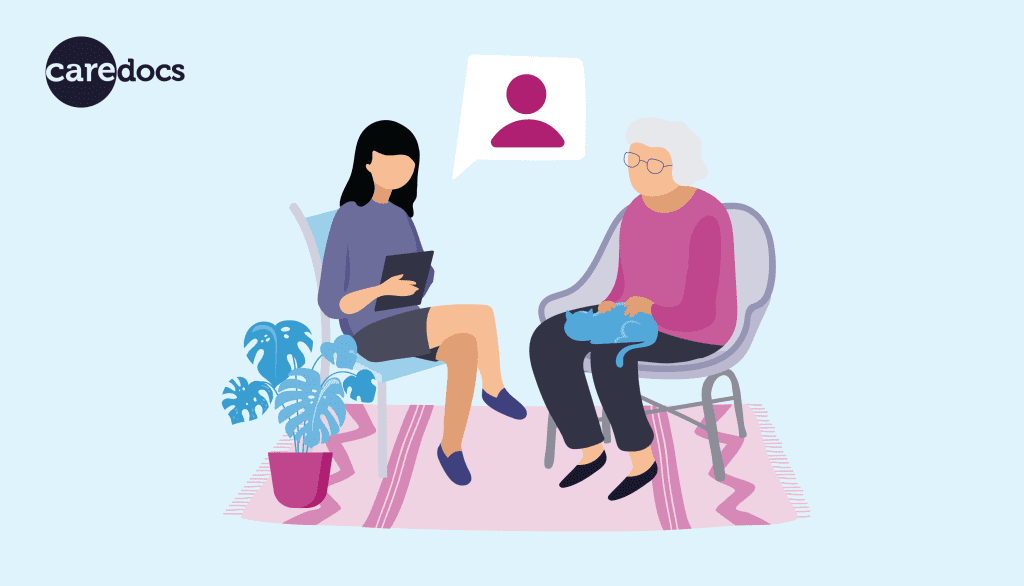Introduction to emotion mapping in adult social care
- Categories: Best Practice & Advice, Ebooks
Joe Webber
Share this article
Download your free ebook!
Don’t forget to grab your copy of our free Introduction to emotion mapping in adult social care ebook…
Contents

Welcome
‘How are you?’ In care homes, nursing homes and domiciliary care services, it’s second nature to ask this question. However, recording emotional responses isn’t widely practiced – at least not in a clear and organised way.
Normally, feelings and actions would be recorded in the form of a daily care note. But relying solely on written text notes to locate information has some limitations. It’s difficult to search for specific data, so most people would need to read through entire records to pinpoint how residents felt during an event. On a larger scale, monitoring how residents’ emotions develop throughout days, weeks or months, can be an intimidating task. This is where emotion mapping can transform your service.
Emotion mapping is a simple process that doesn’t involve making changes to your care service, other than highlighting an emotion at the point of recording. Instead of reading through entire records to determine how someone was feeling – you can just look at the emotional response. The daily note recording then provides more context.
This ebook covers the basics of emotion mapping in adult social care, including the benefits, how emotions are recorded, the tools that are used and how technology can help.
Disclaimer: This is intended for adult social care use only. Emotion mapping for children involves different methods and tools. Emotion mapping is also not the same as ‘emotional journey mapping’, which some care services use to visually follow a journey of emotions for a planned series of events to understand a patient’s experience (i.e. someone who suffers from anxiety and requires a long stay in hospital and surgery.)
What is emotion mapping?
Emotion mapping is a method of recording emotions, moods or behaviours. It’s used by healthcare professionals to keep track of an individual’s experiences within a healthcare service in relation to specific events. This is normally done with the assistance of a visual aid tool, such as a chart containing a variety of emotion types to choose from.
Logging emotions, both in everyday and unique situations, provides important data that can be used to improve the service in some way. You can monitor and compare emotional responses over time to optimise a client’s care, find anomalies in mood or gauge a collective feeling. This helps you gain a deeper insight into the service and evidence when something is going right or discover if certain people or events require attention.
Emotion mapping tools
Depending on who you ask, there are a different number of emotions that we experience. A study in the 1970s by psychologist Paul Eckman identified six basic human emotions. These six emotions are still commonly referenced today. More recently, scientists have named as many as 27 categories of human emotions. The list ranges from common emotions, like ‘anxiety’ and ‘confusion’ to some more surprising entries like ‘aesthetic appreciation’, ‘entrancement’ and ‘triumph’.
Emotion mapping tools are designed to help people put into words how they are feeling. Not everybody has the vocabulary to express themselves accurately. This is in part due to emotions being psychological states. They are subjective to each person because only we know how we feel.
In the 1980s, Robert Plutchik – a renowned psychologist, researcher and professor – considered there to be eight core emotions: anger, fear, sadness, disgust, surprise, anticipation, trust, and joy. He found they were each triggered by certain events and theorised that these emotions could increase or decrease in intensity. For example, ‘annoyance’ could be interpreted as a lesser form of anger, whereas ‘rage’ could be a more extreme form.
To visualise his findings, Plutchik created one of the most widely used models for identifying emotional responses, referred to as the ‘Plutchik wheel’ or ‘Plutchick’s wheel of emotions’. This wheel is essentially a colour-coded diagram that contains the eight primary emotions and all of their derivative states. Many people now use this tool, or simplified versions, to support emotion mapping and monitoring in social care.

What are the benefits of recording emotions?
Recording emotions as part of a normal care service takes little effort, yet it provides major benefits that contribute to the success of your residents and the business. Establishing how someone is feeling or observing a behaviour at the point of care opens the door to conversations about deeper subjects, rather than focusing just on the details of the event taking place. Practising effective communication is a great way to build trust and relationships – leading to a more transparent and efficient care service.
It doesn’t take long before you can take advantage of your new emotion mapping data. In some cases, you can benefit immediately. Identifying emotional states and their triggers will support you by verifying what part of your service is or isn’t working for a resident – essentially helping you get to know them better. By reviewing the data, learning preferences or personality traits and making changes each time you return to an event, you can optimise each person’s service and enhance safeguarding.
Example scenario (short-term benefits): Lunchtime has ended and a carer notices that a resident named John has left some food on their plate. This isn’t unusual but they want to record the event anyway in the form of a daily care note. Instead of simply documenting that John didn’t finish his meal, the care worker asks the resident if they are feeling all right:
“You seem down today. How are you feeling? Unhappy, dissatisfied, depressed?”
John identifies with ‘depressed’ and explains he is missing his family, who aren’t able to visit so much anymore. The lack of visits has been getting to him and is affecting his mood and appetite. The carer feels more socialising can help and writes their daily note:
‘John was feeling down at lunch today, causing him to not finish his food. He mentioned he’s feeling lonely and could use more company. We discussed the idea of getting him involved in more activities so he can socialise more, which he seemed keen to try.’
In response to this, John’s care plan is updated to state he should eat in groups when possible and attend more social activities to help him make friends. Within days, John became happier and started eating his meals again.
Long-term, you have the ability to keep track of emotional responses to different events, activities and situations over time. Having this information at hand helps you to see if there are any abnormalities in behaviour so you can investigate why a change has occurred. You can then follow this up with your own response and demonstrate how you rectified a situation.
Example scenario (long-term benefits): You review a resident’s emotional responses to everyday events over the past several months and notice that the individual tends to feel ‘anxious’ or ‘irritated’ in the evening, but they can’t explain why. However, throughout the rest of the day, they normally show no signs of distress and otherwise seem satisfied with their routine.
Upon further inspection, you conclude this trend of behaviour to be associated with ‘sundowning’. You follow up by creating a more fulfilling routine and gradually see an improvement in their emotional response over the next months.
Why is emotion mapping important in social care?
It’s important to understand how your residents are feeling both mentally and physically to help provide them with the best possible care. This is something inspectors take into account when giving improved ratings. Without the proper tools in place, it can be difficult to spot or monitor potential problems that cannot be seen with the eye, such as poor mental health or internal health conditions like pain (e.g. body mapping). Emotion mapping is one tool that gives you extra insight, as it prompts you to ask questions about feelings, behaviour and mood.
Mental wellbeing is also sometimes linked to physical wellbeing, and vice versa. Attitudes, behaviours and personal feelings can vary over time, and there may be an underlying health reason for it. Identifying when unusual emotional responses occur, and if there seems to be a pattern of behaviour, could shed light on if there’s a deeper problem which needs investigating. For example, if negative emotions are being expressed during a specific activity or at certain times of the day.
Alternatively, a behaviour might be triggered by an act rather than a health issue. This relates back to Plutchik’s theory that each emotion is a reaction to a stimulus event. If a resident suddenly stopped being their usual chatty self – this behaviour could be associated with being ‘scared’ or ‘nervous’. This raises the question, what event could have caused this? It’s possible that something distressing has happened, and taking immediate action may be necessary to ensure their safety.
In addition to supporting residents, recorded emotional responses can be used as evidence to add another layer of protection for businesses. Inspectors will look for the different methods you use to understand your residents and how you respond.
By keeping detailed records which journal a resident’s journey through an ordeal or treatment for a health condition, you can demonstrate how you have effectively safeguarded them and improved their experience. Essentially, showing that you didn’t ignore concerns when they were identified, in case any questions arise about an individual’s wellbeing.
Example scenario (wellness investigation): One of your residents, named Jenny, has been at your home for several years. Jenny’s daughter filed a complaint saying that her mother is being neglected and wants to leave. This comes as a shock because you’ve always had a good relationship with them and there had been no prior warnings.
You check through Jenny’s daily note records and emotional responses and see that it is generally all very positive. There have been occasions where negative emotions were identified but acted on quickly to resolve the situation – nothing to signal neglect. You show Jenny’s daughter the records to demonstrate that Jenny’s wellbeing and safety have not been put at risk.
Finally, you speak to Jenny and ask her to confirm the records reflect her true experience. Jenny’s daughter eventually changes her mind and decides to drop the complaint. There are a number of reasons why Jenny’s daughter might have made these allegations – even mistakenly. But having a detailed record of Jenny’s emotional responses toward her service has helped protect the business.

How to make an emotion map for social care
Types of emotion map
Emotion mapping tools are mostly just a visual reference. You don’t need to have a specialist tool to record a resident’s emotions – but it helps! They are useful reminders for helping you choose from a broader range of responses, and assigning each emotion a colour further supports you by making it easier to locate concerning entries. For those reasons, it’s beneficial to have some type of tool to assist you.
There’s no right or wrong way to map emotions, but common emotion mapping tools include:
- Emotion wheels
- Emotion charts, emoticons or symbols (e.g. happy and sad faces)
Alternatively, you could use:
- A written list of emotions
- Scale charts (e.g. 1 to 5)
Making an emotion map
If you would like to make your own map, it’s advantageous to decide on a set of emotions to choose from. This will improve consistency and efficiency by helping staff become more selective and reduce the number of vaguer entries that might slow down your analysis later on.
Emoticons or symbols are more effective for people who are not able to express themselves verbally or have difficulty communicating. They might feel more comfortable pointing at a picture of a face that represents their current mood. This method is limited in terms of providing specific feedback (e.g. the reason for choosing a ‘sad face’), but for certain groups of people, it is ideal to increase understanding of wellbeing.
There are free resources online that you can print and attach to a resident’s care records. Here’s a chart we created that you are welcome to download and print. Alternatively, consider using a care software that has an effective tool programmed in so you don’t need to use paper or printer ink. We’ll cover the benefits of using technology for this purpose more in the final chapter of this ebook.
Using paper emotion maps vs digital emotion maps
To create your own paper emotion map, the basic steps are:
- Decide on which tool would be most effective for your setting.
- Define a set of common emotions that can be applied to multiple situations/events. This can be fine-tuned over time.
- Design the mapping tool on a computer or draw it by hand. You should also include spaces to record information about the point of care (e.g. time, date, staff name).
- Assign each emotion a distinct colour. Use logic that helps people associate the emotion with the colour (e.g. red for ‘anger’).
- Print the emotion map or photocopy it in colour. A new copy should be used for each new daily care note recording, as the emotion will be marked/circled directly on the page.
- After recording an emotion, attach the emotion map to the related daily care note and add it to the individual’s care file.
Electronic emotion mapping tools are found on many digital care management systems. For example purposes, here’s how you can create one using CareDocs:
- Create a new digital daily care note. You will see an electronic emotion mapping tool linked to the note.
- Select the emotion by clicking it, then complete the daily note.
- Your record saves automatically to your digital database.
Emotion mapping on paper is by far the more complicated way of introducing the tool into your service. The level of research, admin work and technical ability needed to produce a professional-looking map can be time-consuming and costly. However, the bulk of the work can be avoided if you download a free emotion map template.
On the other hand, finding a care software that’s right for you and contains all the features you’re looking for can also take time. We recommend always booking a free demo before making any decisions. This is something that all social care businesses will need to consider eventually, as the DHSC is aiming for total digitalisation across the sector. With additional benefits, services and plenty of digital features that allow you to completely transform your business – care software is a necessary investment.
In both scenarios, for maximum benefit, training should be provided on how to effectively use the emotion mapping tool, and an explanation of what you’re trying to gain from doing so.
How to record emotional responses
The emotion mapping process is normally done in conjunction with creating a daily care note. For best results, make it a habit to log an emotional response each time you are recording a new event. This includes the time, date and name of the staff member performing the task.
Begin by having a conversation with your residents and ask them how they are feeling. If they can’t express their mood, use your judgement to choose an accurate emotion from the defined list. If the mood they described isn’t on the list, match it with the closest possible option and record the full details of the response in the daily care note for reference.
Mark the chosen emotion on the map (underline, circle, etc.). If using paper, a blank emotion map sheet must be used for each new recording to avoid confusion. You don’t need to push for a response if no obvious emotion is being displayed – in many cases an individual might just be ‘content’ with a situation.
Accuracy is key when recording emotions as your data can be used to evidence that you are identifying and responding to information effectively. If nine out of ten coffee events have ‘content’ as a recorded emotional response and the tenth event is marked as ‘irritated’ then that’s cause for investigation.
When the emotion is recorded before the details of the event (e.g. drinking a coffee), it makes it easier for your daily note to be reflective of the person and not just the event. For example, instead of simply stating that a resident had a coffee, you can expand on their feeling.
Exploring why a resident might have felt ‘dissatisfied’ with their coffee demonstrates a person-centred approach to care where their experience is being put above all else. For example, perhaps the resident didn’t like the brand of coffee but was too polite to mention it. If you’re able to resolve an issue, the next time you record a coffee event, the resident could indicate they are ‘happy’, proving you have succeeded in improving their experience.

How can technology help with emotion mapping?
Using paper to record care information of any kind has its downsides. You need to keep on top of inventory, responsibly dispose of waste, find somewhere to securely store your documents and keep it well organised. Paper management systems come with time-consuming administrative tasks that can be eliminated from your workload by choosing a care software. Implementing technology in your care business has many benefits – and below explains how it can specifically help with emotion mapping.
Emotion mapping and daily care note recording go hand-in-hand. Instead of treating these as two separate actions, it’s beneficial to find a digital care system that puts these tools together for increased efficiency. You will be able to see everything you need on a single screen to ensure total consistency between the emotional response and the written record.
Care software which features an emotion mapping tool will have set responses, which are colour-coded. This will save you from creating your own or sourcing a version from somewhere else. You won’t need to print copies, which when using colour, might work out as a costly option. To digitally select an emotion, normally you would find the best corresponding response and click on it.
Because all records you save in digital systems form part of the same database, this makes it simple to review lots of information with minimal effort. You can generate instant reports to analyse how individuals respond to multiple events over a time period, creating a timeline or emotional journey. Or how multiple individuals have responded to the same event (e.g. a social activity). Digital records and reports can save each staff member from hours of admin work every week.
To learn more about CareDocs and the benefits and features we offer, please book a free demo with one of our friendly Business Development Managers, email sales@caredocs.co.uk or call 0330 056 3333 (opt. 2).
If you require assistance with the CareDocs software, we’re standing by to provide support. Email support@caredocs.co.uk or call us on 0330 056 3333 (opt. 1).
Sources
Imperial NHS: https://www.imperial.nhs.uk/~/media/cc4c/documents/emotional-mapping-how-to-guide-2221-002.pdf
Healthline: https://www.healthline.com/health/emotion-wheel#plutchik-wheel
Country Living: https://www.countryliving.com/uk/wellbeing/news/a2454/27-human-emotions-new-study/
Verywell Mind: https://www.verywellmind.com/an-overview-of-the-types-of-emotions-4163976
Download your free ebook!
Don’t forget to grab your copy of our free Introduction to emotion mapping in adult social care ebook…
Share this article
Author
Joe Webber
Search
Recent articles
- CareDocs Partners with the Professional Record Standards Body (PRSB) to Support Care Standards Fit for the Future of Digital Care January 30, 2024
- CareDocs Joins the Care Software Providers Association (CASPA), an Independent, Not for Profit Association, Representing Software in the Care Industry January 19, 2024
- CareDocs partners with Bristol Waste to tackle digital poverty January 10, 2024
Recent comments
- 1.2. Assess use of care plans in applying person-centered values - CIPD Writers on What is person centred care planning and why is it important?
- Call tracking tips for care home marketers - Chester Times on The importance of effective communication in care
- Why is effective communication important for positive relationships with individuals in care? - Building-Craft on The importance of effective communication in care










